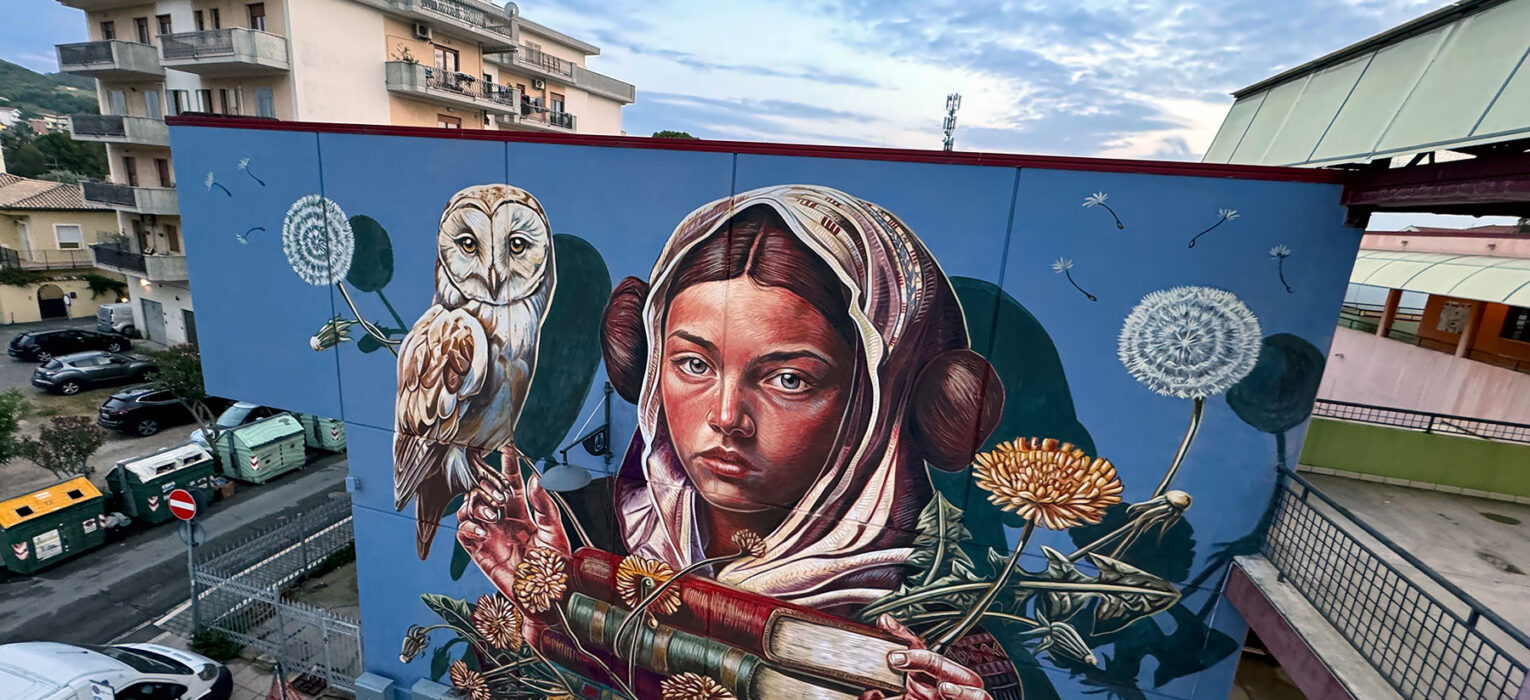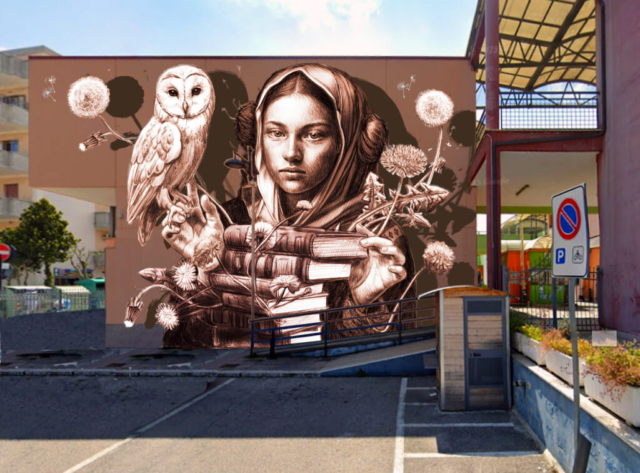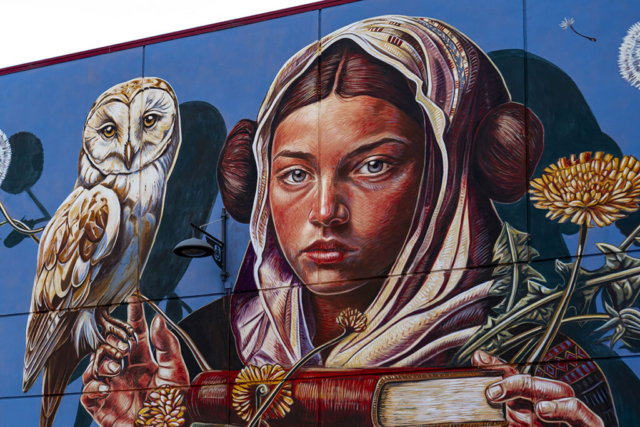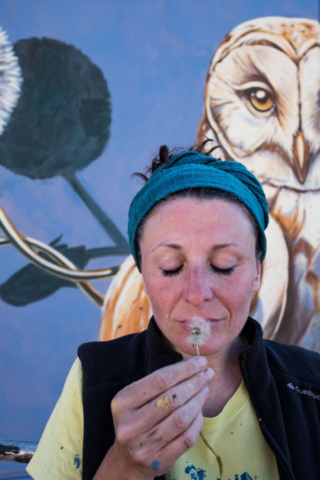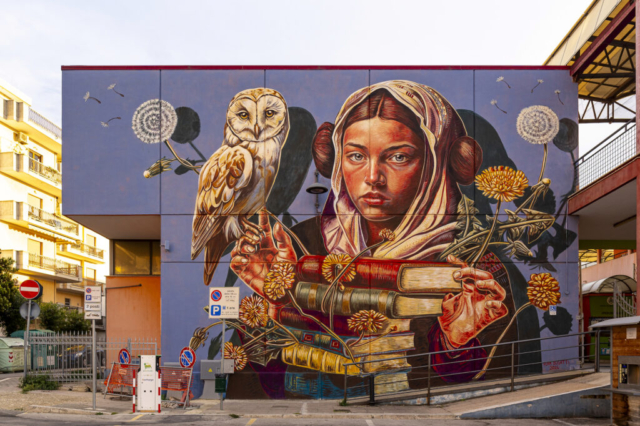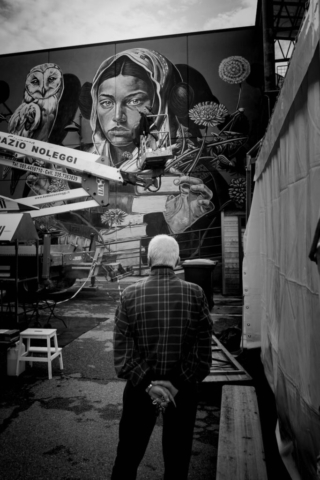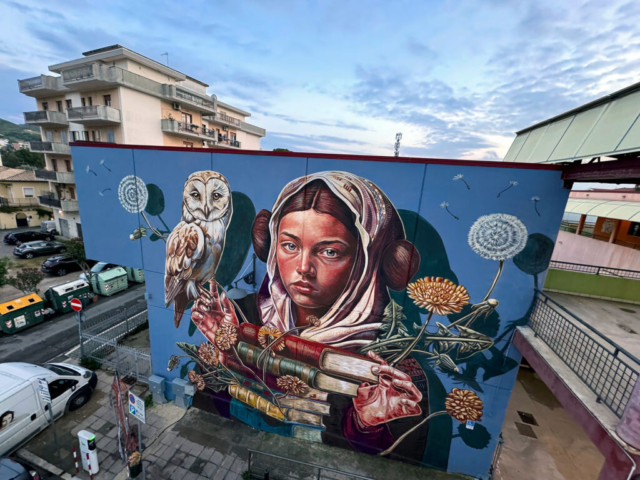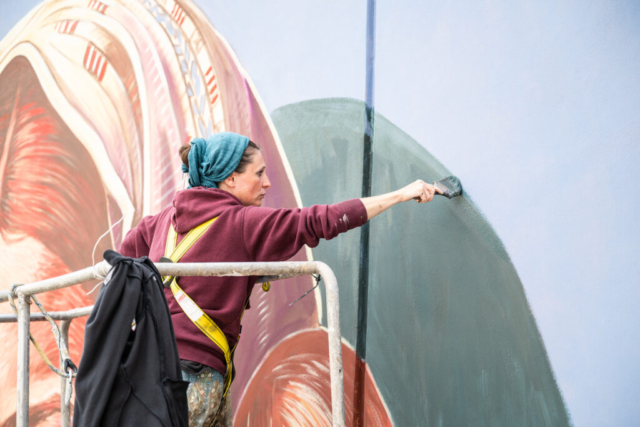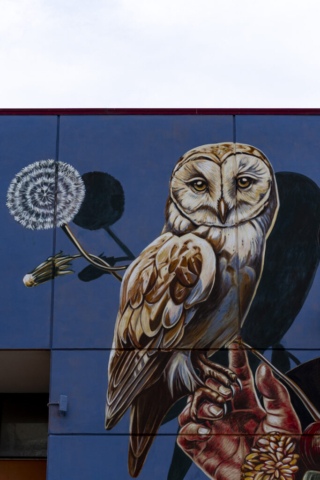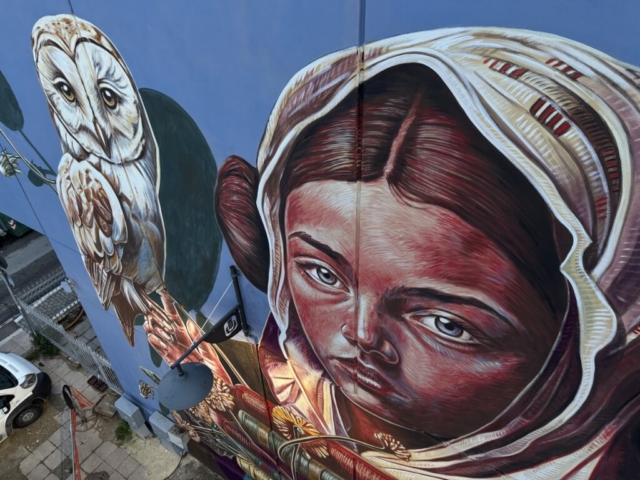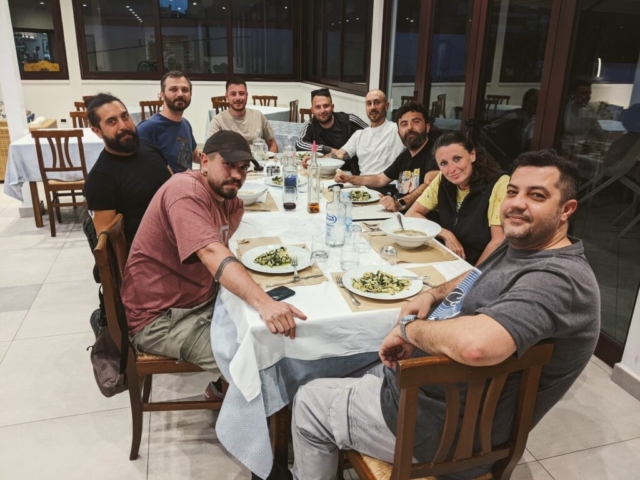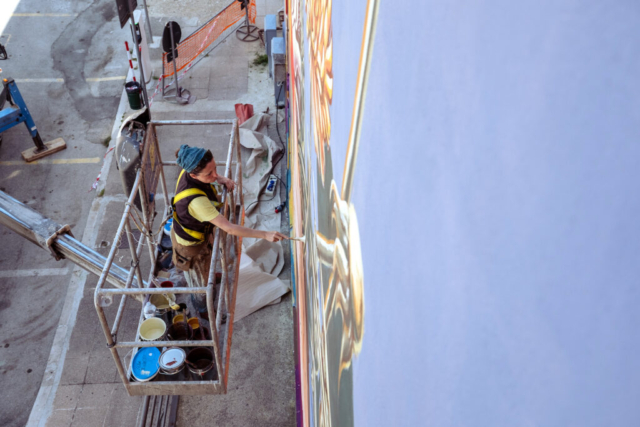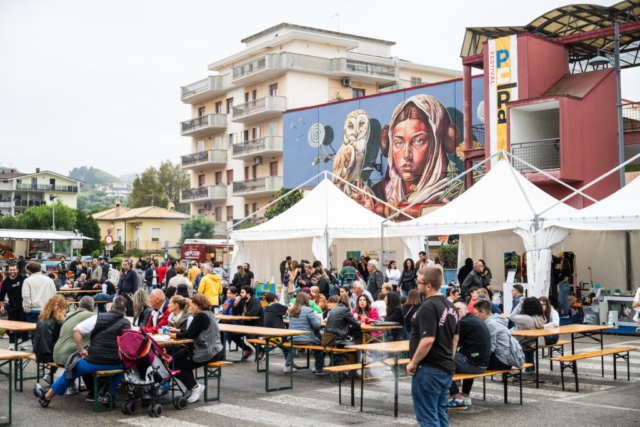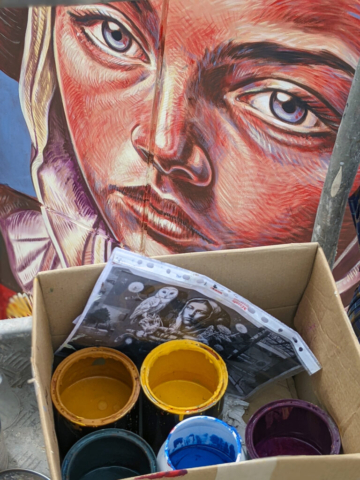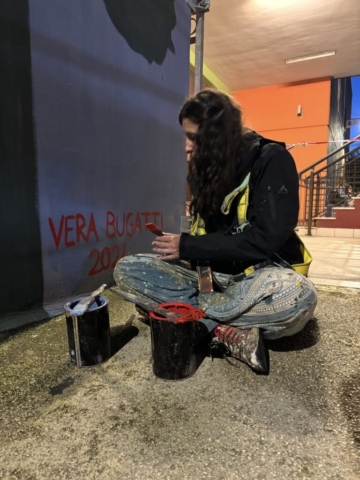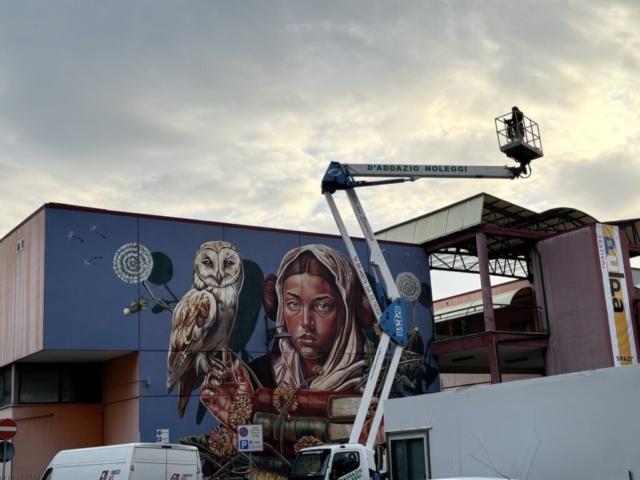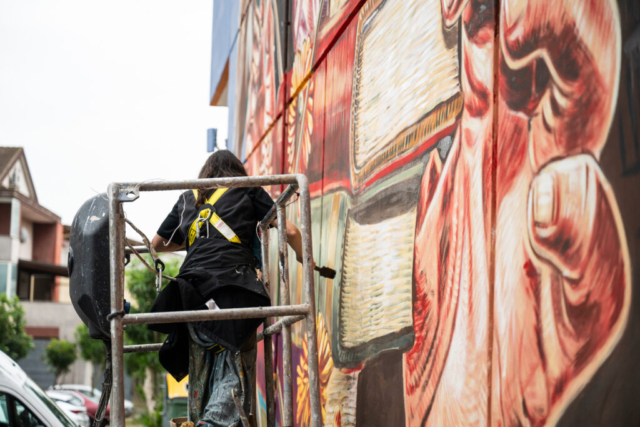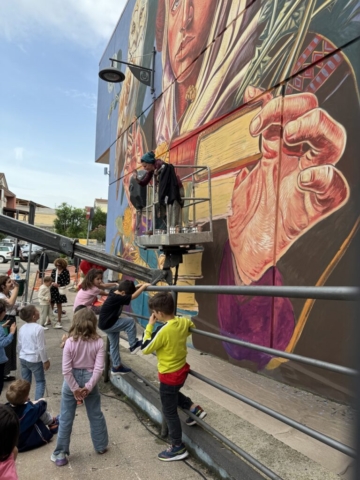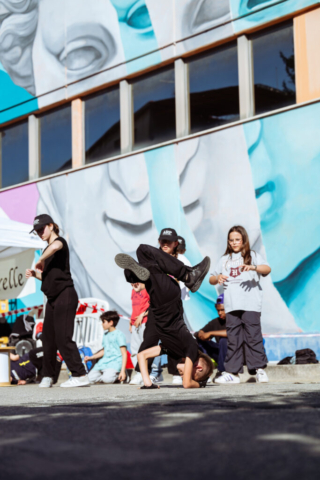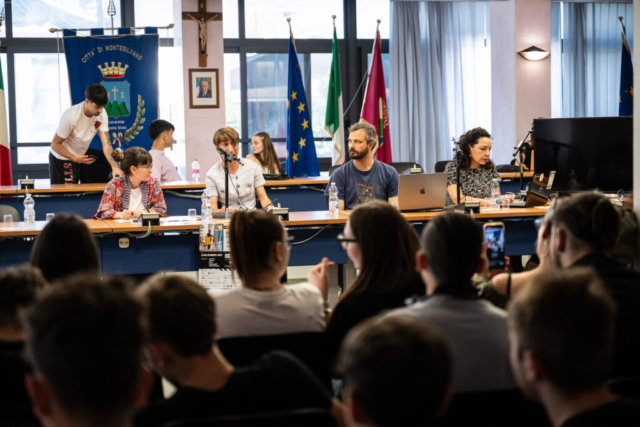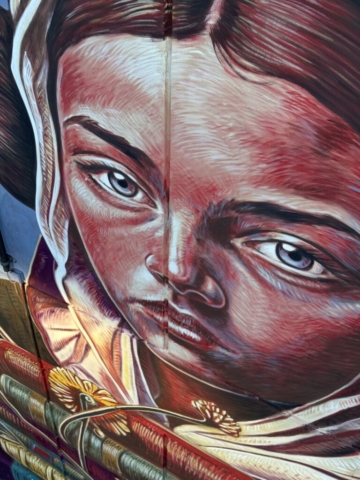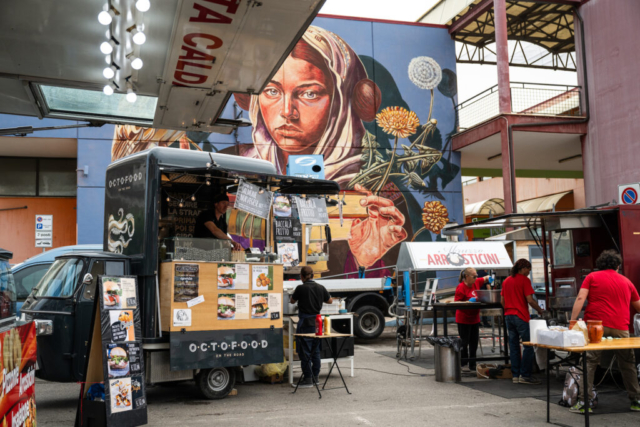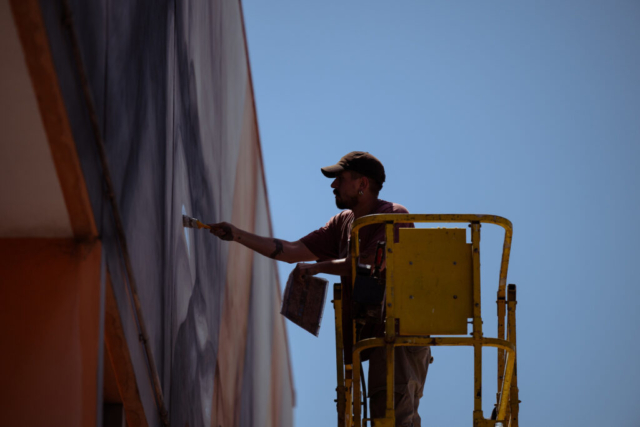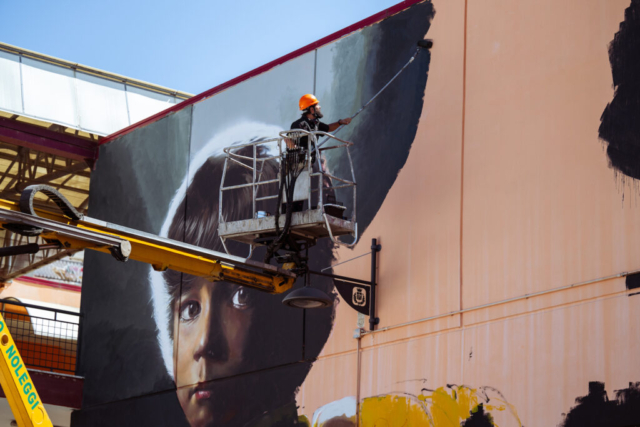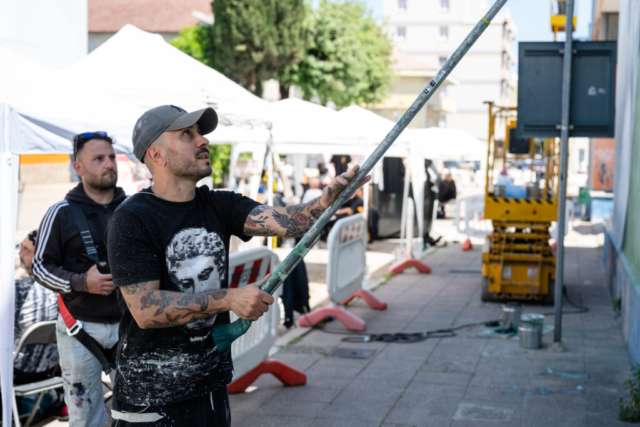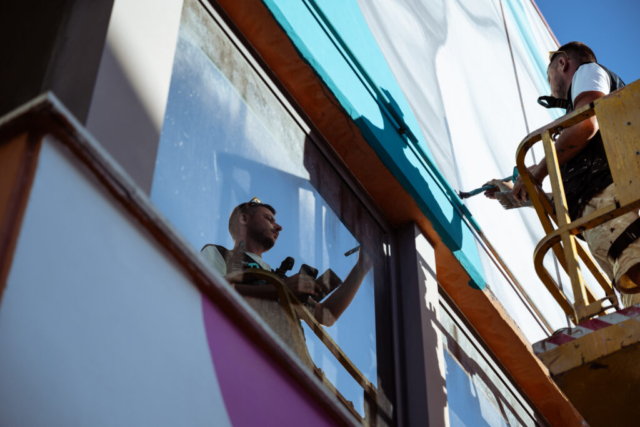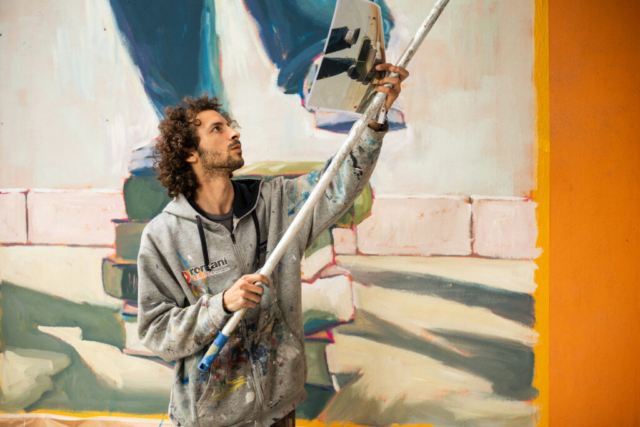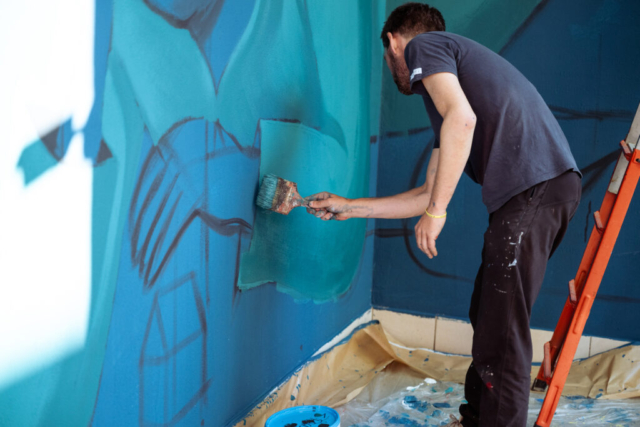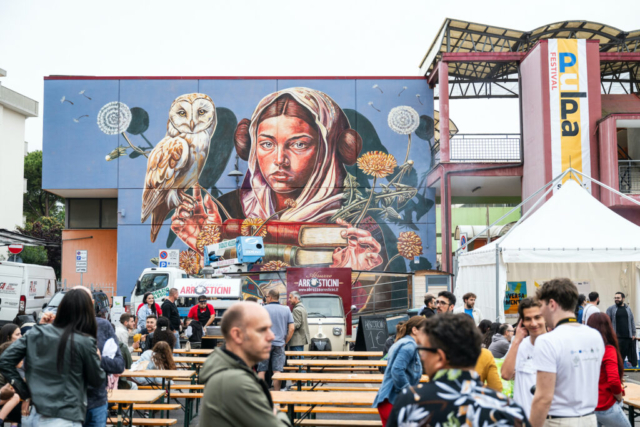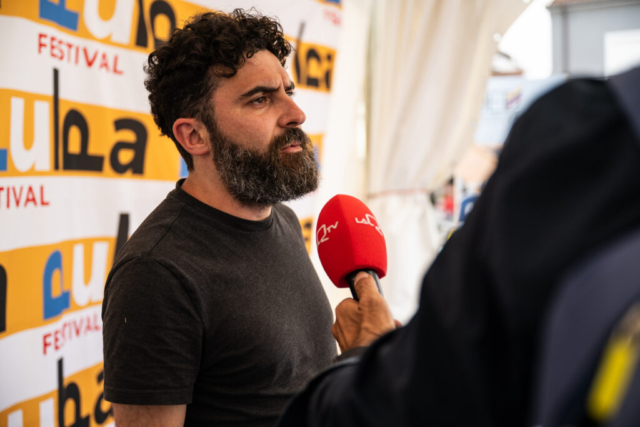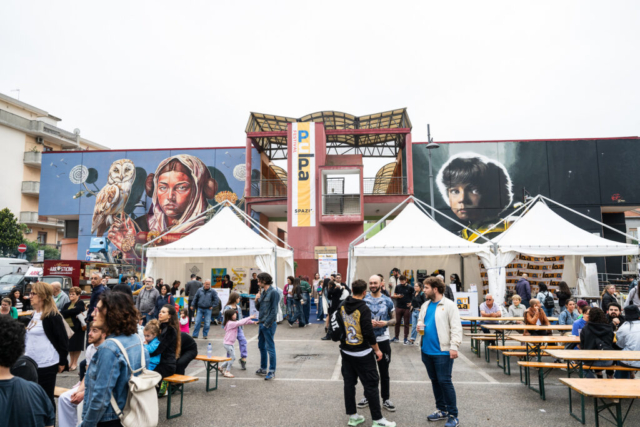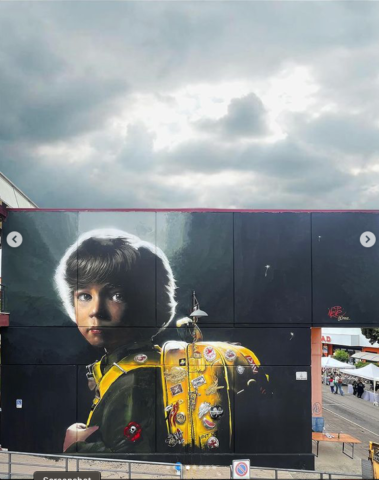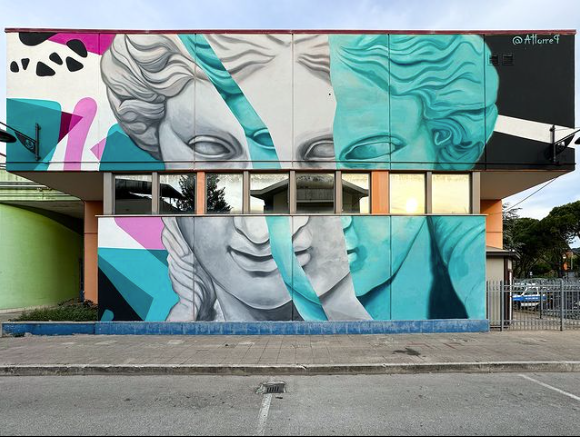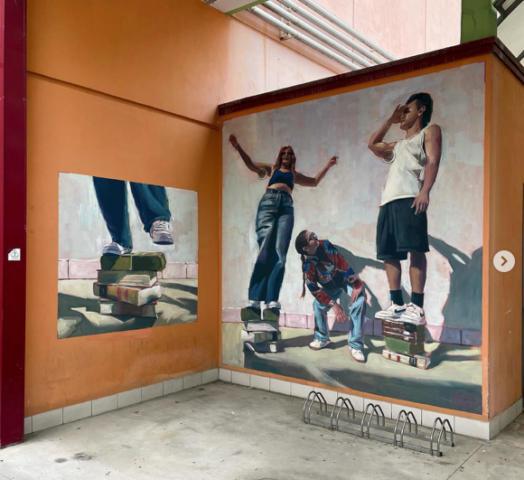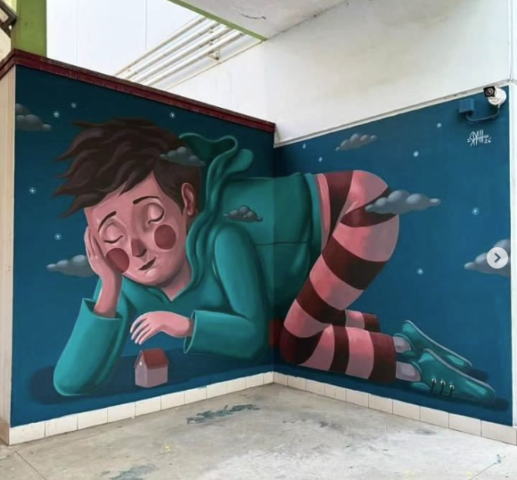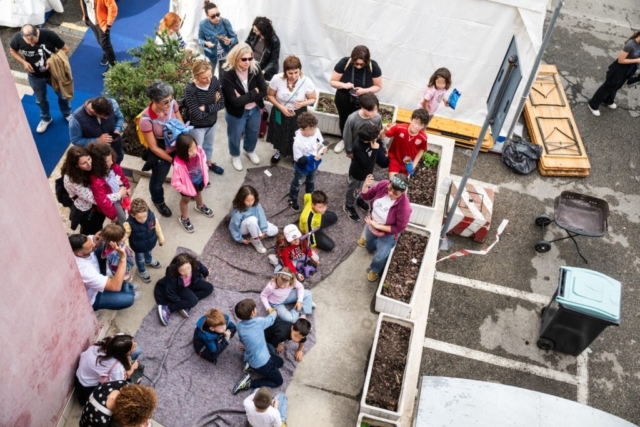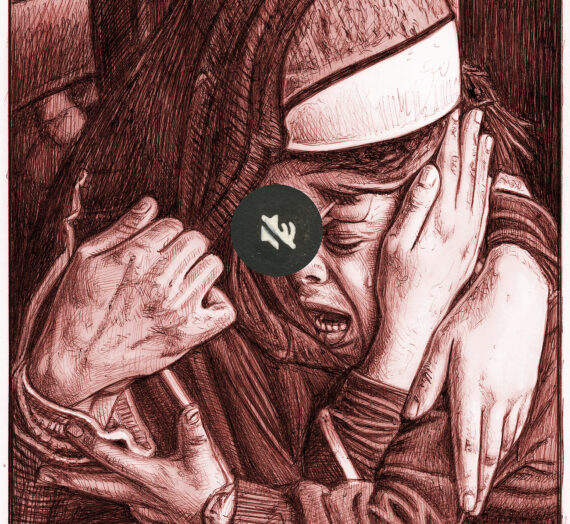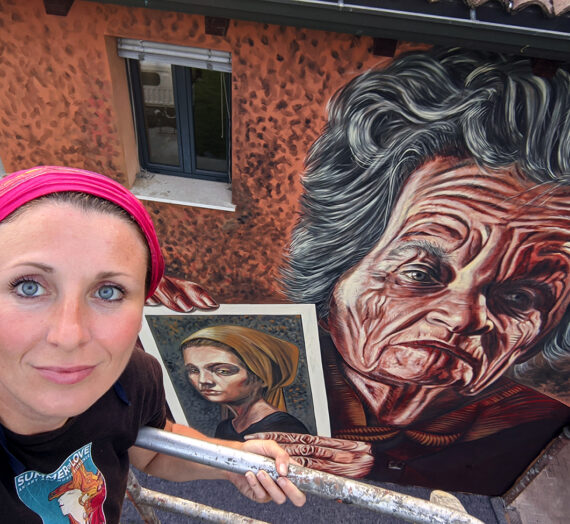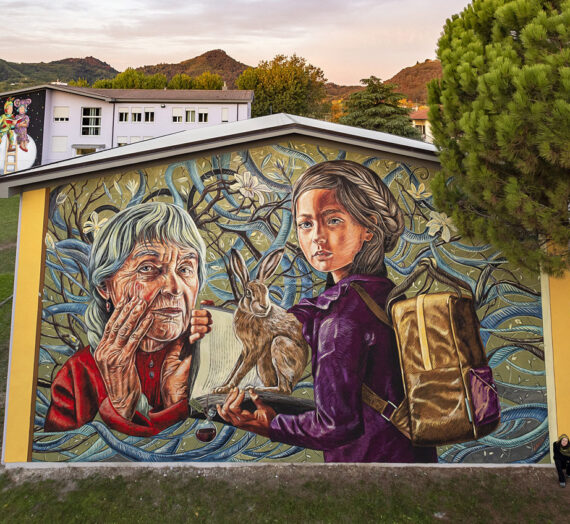A volte le opere sfuggono ai loro creatori, prendono strade impreviste, vivono di vita propria.
Di solito le tengo strette, a volte le forzo consapevolmente in una direzione, ma sono più forti di me, cariche di un significato che non è quello previsto.
Credo sia accaduto quest’anno al Pulpafestival di Montesilvano, col il pezzo “InterColtura”: più che un’interpretazione personale del tema si è trasformata in un’epifania che sfugge ad una comprensione totale.
Forse avevo bisogno di liberare dei fantasmi, tante sono state le ore passate lassù mentre gli amici minacciavano ironicamente di togliere le chiavi dalla piattaforma (dopo blocchi vari della macchina che, a sua volta, mi si opponeva).
Così è nata una donna enigmatica dalla strana acconciatura che guarda l’osservatore mentre un barbagianni le si posa sulle dita. Davanti all’apparente ritrosia di lei alcuni ingombranti volumi sono appoggiati uno sopra l’altro e fiori gialli dei vari tipi di tarassaco sembrano generarsi dalle pagine ad indicare la ‘coltura’ di qualcosa di prezioso, eterogeneo seppur apparentemente uniforme.
Il tarassaco officinale o dente di leone, un fiore considerato simbolico (Cattabiani nel suo Florario lo definisce ‘oracolo vegetale’), evoca immediatamente l’idea di transitorietà poiché i suoi acheni arrivano a disperdersi molto lontano dal luogo di origine. È evanescente (basta un soffio!) e potente allo stesso tempo, impermanente ed efficace, perfetto e iconico come un talismano di vanitas, che tutti i luoghi raggiunge. Non l’avevo mai disegnato.
Il barbagianni a sua volta è fra i rapaci notturni più diffusi al mondo, facilmente riconoscibile per quel disco facciale a forma di cuore e per il piumaggio quasi del tutto bianco, ma è spesso vittima di superstizioni, soprattutto per via del suo verso prolungato e stridente, molto diverso da quello di gufi e civette. Nell’opera ho voluto fosse un simbolo di saggezza ma anche di percettività acuta, della capacità di andare oltre le apparenze per vedere la verità di ogni cosa.
Intercultura quindi come qualcosa che al contempo sia assolutamente necessario per la tessitura delle relazioni ma delicato e continuamente in biblico fra intento e complessità dei saperi identitari. Per questo i libri non hanno nessun titolo preciso, forse uno ha addirittura le pagine bianche.
E la donna? In lei mi sono smarrita, profondamente.
Pensavo potesse rappresentare l’idea stessa di intercultura, una personificazione ambigua che molti aspetti ricordasse senza raccontarne con esattezza nessuno, che evocasse senza confermare.
Mi hanno chiesto se fosse una figura storica del luogo, una sibilla, una studentessa musulmana, una contadina bulgara, una principessa Leila, una vergine rinascimentale, una strega. Nessuna di queste e tutte medesimamente, non lo so più.
Non mi ha convinto dalle prime pennellate, non mi piaceva e per quello continuavo ad insistere e a tracciare fino allo sfinimento. Non era uno dei miei volti, si capiva subito e la cosa mi allarmava perché è attorno ai visi che di solito completo l’opera mentre qui tutto fioriva attorno ad un sembiante che mi era totalmente sfuggito.
Ero altrove con la mente e col cuore perché pensavo ad una persona cara che stava male e che ora non è più qui. Più lavoravo più credevo di trovare la pace ma quel viso restava un dilemma.
Così la donna forse si è fatta da sola e un po’, mi hanno fatto notare, mi somiglia (solo che lei non fa le battute, per fortuna).
Alla fine io ero evanescente e lei imponente, io tacevo e lei raccontava la storia, solo che non l’ho ascoltata fino in fondo. I soffioni la riporteranno lontano mentre i bambini sogneranno barbagianni.
Ringrazio Andrea Lucente per avermi segnalato la poesia “Salvezza” di Gozzano, che ben si accorda con l’idea di fragilità della vita individuale, dei momenti, dei ricordi, delle comunità che in quest’opera inconsapevolmente ho raccontato.
Un super grazie al curatore Enrico Peca e agli artisti presenti (Neve, Valiante, Ligama, Attorrep, Edoardo Ettorre, Attilio Spagnuolo)
Le fotografie sono di Andrea Lucente, Alberto di Febo e Ilaria Turini.
Sometimes works escape their creators, take unexpected paths, live a life of their own.
Usually I hold them tight, sometimes I consciously force them in one direction, but they are stronger than me, full of a meaning that is not the one expected.
I think it happened this year at the Pulpafestival in Montesilvano, with the piece “InterColtura”: more than a personal interpretation of the theme, it turned into an epiphany that eludes total understanding.
Maybe I needed to free some ghosts, so many hours were spent up there while my friends ironically threatened to remove the keys from the platform (after various blocks of the machine which, in turn, opposed me).
Thus, was born an enigmatic woman with a strange hairstyle who looks at the observer while a barn owl lands on her fingers. In front of her apparent reluctance, some bulky volumes are placed one on top of the other and yellow flowers of the various types of dandelions seem to generate from her pages to indicate the ‘cultivation’ of something precious, heterogeneous albeit apparently uniform. The officinal dandelion or dandelion, a flower considered symbolic (Cattabiani defines it as a ‘vegetable oracle’ in his Florario), immediately evokes the idea of transience since its achenes end up dispersing very far from their place of origin. It is evanescent (just a breath is enough!) and powerful at the same time, impermanent and effective, perfect and iconic like a vanitas talisman, which reaches all places. I had never drawn it.
The barn owl in turn is among the most widespread nocturnal birds of prey in the world, easily recognizable by its heart-shaped facial disk and its almost completely white plumage, but it is often the victim of superstitions, especially due to its prolonged and strident cry, very different from that of owls and owls. In the work I wanted it to be a symbol of wisdom but also of acute perceptiveness, of the ability to go beyond appearances to see the truth of everything.
Interculture therefore as something that is at the same time absolutely necessary for the weaving of relationships but delicate and continuously biblical between intent and complexity of identity knowledge. This is why the books have no precise title, perhaps one even has blank pages.
And the woman? I lost myself in her, deeply.
I thought she could represent the very idea of interculture, an ambiguous personification that remembered many aspects without describing any of them exactly, that she evoked without confirming. They asked me if she was a local historical figure, a sibyl, a Muslim student, a Bulgarian peasant, a Princess Leia, a Renaissance virgin, a witch. None of these and all of them equally, I no longer know.
She didn’t convince me from the first brushstrokes, I didn’t like her and that’s why I kept insisting and tracing until I was exhausted. She was not one of my faces, she was immediately understood and this alarmed me because it is around the faces that I usually complete the work while here everything flourished around a face that had totally escaped me.
I was elsewhere with my mind and heart because I was thinking of a loved one who was ill and who is no longer here. The more I worked the more I thought I would find peace but that face remained a dilemma. So, the woman perhaps made herself and a little, they pointed out to me, she resembles me (except that she doesn’t make jokes, fortunately).
In the end I was evanescent and she was imposing, I was silent and she told the story, only I didn’t listen to the end. Her dandelions will take her far away while the children will dream of barn owls.
I thank Andrea Lucente for having pointed out to me the poem “Salvezza” by Gozzano, which fits well with the idea of fragility of individual life, of moments, of memories, of communities that I have unconsciously recounted in this work.
